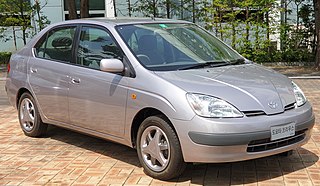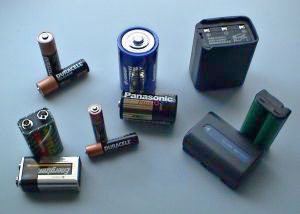
A hybrid vehicle is one that uses two or more distinct types of power, such as submarines that use diesel when surfaced and batteries when submerged. Other means to store energy include pressurized fluid in hydraulic hybrids.

Hitachi, Ltd. is a Japanese multinational conglomerate founded in 1910 and headquartered in Chiyoda, Tokyo. The company specialises in a diverse range of products, including digital systems, power and renewable energy solutions, railway systems, healthcare products, and financial systems.

A rechargeable battery, storage battery, or secondary cell, is a type of electrical battery which can be charged, discharged into a load, and recharged many times, as opposed to a disposable or primary battery, which is supplied fully charged and discarded after use. It is composed of one or more electrochemical cells. The term "accumulator" is used as it accumulates and stores energy through a reversible electrochemical reaction. Rechargeable batteries are produced in many different shapes and sizes, ranging from button cells to megawatt systems connected to stabilize an electrical distribution network. Several different combinations of electrode materials and electrolytes are used, including lead–acid, zinc–air, nickel–cadmium (NiCd), nickel–metal hydride (NiMH), lithium-ion (Li-ion), lithium iron phosphate (LiFePO4), and lithium-ion polymer.

The lead–acid battery is a type of rechargeable battery first invented in 1859 by French physicist Gaston Planté. It is the first type of rechargeable battery ever created. Compared to modern rechargeable batteries, lead–acid batteries have relatively low energy density. Despite this, they are able to supply high surge currents. These features, along with their low cost, make them attractive for use in motor vehicles to provide the high current required by starter motors. Lead–acid batteries suffer from relatively short cycle lifespan and overall lifespan, as well as long charging times.

Distributed generation, also distributed energy, on-site generation (OSG), or district/decentralized energy, is electrical generation and storage performed by a variety of small, grid-connected or distribution system-connected devices referred to as distributed energy resources (DER).

The Restriction of Hazardous Substances Directive 2002/95/EC, short for Directive on the restriction of the use of certain hazardous substances in electrical and electronic equipment, was adopted in February 2003 by the European Union.

An automotive battery, or car battery, is a rechargeable battery that is used to start a motor vehicle. Its main purpose is to provide an electric current to the electric-powered starting motor, which in turn starts the chemically-powered internal combustion engine that actually propels the vehicle. Once the engine is running, power for the car's electrical systems is still supplied by the battery, with the alternator charging the battery as demands increase or decrease.

Grid energy storage is a collection of methods used for energy storage on a large scale within an electrical power grid. Electrical energy is stored during times when electricity is plentiful and inexpensive or when demand is low, and later returned to the grid when demand is high, and electricity prices tend to be higher.

Exide was originally a brand name for batteries produced by The Electric Storage Battery Company and later became Exide Corporation doing business as Exide Technologies, an American multinational lead-acid batteries manufacturing company. It manufactures automotive batteries and industrial batteries. It is based in Milton, Georgia, United States.

A123 Systems, LLC, a subsidiary of the Chinese Wanxiang Group Holdings, is a developer and manufacturer of lithium iron phosphate batteries and energy storage systems.
Exide Industries Limited (Exide) is an Indian multinational storage battery manufacturing company, headquartered in Kolkata, India. It is the largest manufacturer of lead-acid storage batteries and power storage solutions provider in India.

A deep-cycle battery is a battery designed to be regularly deeply discharged using most of its capacity. The term is traditionally mainly used for lead–acid batteries in the same form factor as automotive batteries; and contrasted with starter or 'cranking' automotive batteries designed to deliver only a small part of their capacity in a short, high-current burst for cranking the engine.

Battery recycling is a recycling activity that aims to reduce the number of batteries being disposed as municipal solid waste. Batteries contain a number of heavy metals and toxic chemicals and disposing of them by the same process as regular household waste has raised concerns over soil contamination and water pollution.

An electric vehicle battery is a rechargeable battery used to power the electric motors of a battery electric vehicle (BEV) or hybrid electric vehicle (HEV).

An electric battery is a source of electric power consisting of one or more electrochemical cells with external connections for powering electrical devices. When a battery is supplying power, its positive terminal is the cathode and its negative terminal is the anode. The terminal marked negative is the source of electrons that will flow through an external electric circuit to the positive terminal. When a battery is connected to an external electric load, a redox reaction converts high-energy reactants to lower-energy products, and the free-energy difference is delivered to the external circuit as electrical energy. Historically the term "battery" specifically referred to a device composed of multiple cells; however, the usage has evolved to include devices composed of a single cell.
Enphase Energy, Inc. is an American energy technology company headquartered in Fremont, California, that develops and manufactures solar micro-inverters, battery energy storage, and EV charging stations primarily for residential customers. Enphase was established in 2006 and is the first company to successfully commercialize the solar micro-inverter, which converts the direct current (DC) power generated by a solar panel into grid-compatible alternating current (AC) for use or export. The company has shipped more than 48 million microinverters to 2.5 million solar systems in more than 140 countries.

EnerSys is a stored energy systems and technology provider for industrial applications. The company manufactures reserve power and motive power batteries, battery chargers, power equipment, battery accessories and outdoor equipment enclosure systems.

Home energy storage devices store electricity locally, for later consumption. Electrochemical energy storage products, also known as "Battery Energy Storage System", at their heart are rechargeable batteries, typically based on lithium-ion or lead-acid controlled by computer with intelligent software to handle charging and discharging cycles. Companies are also developing smaller flow battery technology for home use. As a local energy storage technologies for home use, they are smaller relatives of battery-based grid energy storage and support the concept of distributed generation. When paired with on-site generation, they can virtually eliminate blackouts in an off-the-grid lifestyle.

Usage of electric cars damage people’s health and the environment less than similar sized internal combustion engine cars. While aspects of their production can induce similar, less or different environmental impacts, they produce little or no tailpipe emissions, and reduce dependence on petroleum, greenhouse gas emissions, and deaths from air pollution. Electric motors are significantly more efficient than internal combustion engines and thus, even accounting for typical power plant efficiencies and distribution losses, less energy is required to operate an electric vehicle. Manufacturing batteries for electric cars requires additional resources and energy, so they may have a larger environmental footprint in the production phase. Electric vehicles also generate different impacts in their operation and maintenance. Electric vehicles are typically heavier and could produce more tire and road dust air pollution, but their regenerative braking could reduce such particulate pollution from brakes. Electric vehicles are mechanically simpler, which reduces the use and disposal of engine oil.

The Tehachapi Energy Storage Project (TSP) is a 8MW/32MWh lithium-ion battery-based grid energy storage system at the Monolith Substation of Southern California Edison (SCE) in Tehachapi, California, sufficient to power between 1,600 and 2,400 homes for four hours. At the time of commissioning in 2014, it was the largest lithium-ion battery system operating in North America and one of the largest in the world. TSP is considered to be a modern-day energy storage pioneer with significant accomplishments that have proven the viability of utility-scale energy storage using lithium-ion technology. While originally envisioned as a research and development project, TSP operated as a distribution-level resource for SCE and for calendar year 2020, SCE reported that TSP operated in the wholesale energy market with revenue exceeding operating and maintenance costs. In 2021, SCE began the decommissioning of TSP, which was followed by formal decommissioning by state regulators in 2022. The physical dismantlement of TSP is expected to be completed by the end of 2022.

















